


Factors that create Student Variance:
- Biological factors:
- can cause students to learn in different modes on different timelines,
- some learning parameters are malleable depends on context and level of support
- Degree of privilege:
- students who come from low SES face more school challenges
- quality of students’ support and breadth of experience affects learning
- Positioning for learning:
- parents who value education influence student learning and cultivate soft skills (trust, confidence, positive interpersonal skills, emotional intelligence) that positively impact student learning
- Preferences:
- students’ interests vary across subjects and topics,
- preferences affect how students take in knowledge,
- students will relate to different teachers differently
Benefits of Responsive Teaching:
- Positive student teacher relationships make it easier for students to take risks in the service of learning
- Positive learning environments help students navigate through the successes and failures inherent in learning
- Positive learning environments promote positive academic mindets such as confidence, sense of contribution, autonomy, and accomplishment
- Attending to students’ needs builds bridges between learners and important content
- Adjusting pacing to meet students’ varied readiness helps students learn
- Attending to students’ interests connects content to students’ curiosity
- Attending to varied learning modes helps students use their preferred modes to learn more efficiently
Basic Responsive Teaching Approaches:
- Find ways to get to know students better – call on students by name, using journaling to learning more about students’ feelings and interests
- Use regular small group instruction
- Teach to the high end of rigor – all learners benefit from learning complex ideas and complex thinking patterns
- Use regular formative assessments to monitor understanding, give feedback, and fine-tune instruction
- Teach in multiple ways
- Allow working alone and with peers
- Use clear rubrics that describe high quality work
- Offer more ways to explore and express learning
- Cultivate a taste for diversity – save problems in multiple ways, explore multiple points of view, etc.
- Use basic reading strategies throughout the curriculum
Helpful Guiding Questions
- Whom am I preparing to teach?
- How can my knowledge of my students affect my curriculum design?
- How can I help particular students find themselves in the world of what I am about to teach?
- How might I teach in ways that best reveal the power of design to individuals?
- How can I learn more about my students?
- How can I ensure that all students have full access to the power of this design in accordance with their needs?
 PBL contexts offer many opportunities to differentiate instruction: they already involve complex thinking and have many places for short group instruction. Developing a deliberate and effective approach to responsive teaching can help ALL students be successful in projects.
PBL contexts offer many opportunities to differentiate instruction: they already involve complex thinking and have many places for short group instruction. Developing a deliberate and effective approach to responsive teaching can help ALL students be successful in projects.

Preparation Steps
- Research and implement activities that will identify the variance in students’ interests, learning modes, communication styles, etc.
- Research multiple ways to teach content
- Develop clear rubrics that describe high quality work prior to starting projects
- Try to develop project contexts that consider students’ interests
- Research and implement activities and routines that develop and maintain a positive learning culture
- Allow student voice and choice to influence their products
Early Implementation Steps
- Use project self-pacing, to get students to naturally attend workshops in small groups that match their current need-to-knows
- Teach content and solve problems in multiple ways
- Use rubric check-ins and feedback during guided practice to give students regular, specific feedback that can help them improve their understanding and products
Advanced Implementation Steps
- Teach students about their preferred learning modes, their strengths and challenges, and ways to leverage these modes to learn more efficiently
- Allow student choice to create variety in the problem solving modes and points of view they apply to create project products
- Make regular attempts to get to know students deeper. Use reflections on activities and projects to learn more about how these connect to students’ learning modes and interests, etc.

